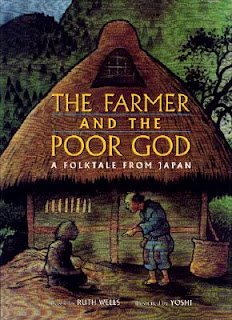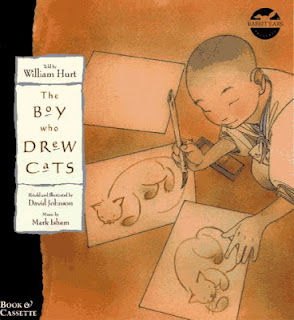I'm quite fond of this somewhat eerie story, which I always called a folk tale, but is apparently a legend about a 15th century artist named Sesshu Toyo. The basic plot of
The Boy Who Drew Cats revolves around a clever young boy, too weak to work in the fields, who is taken to a temple to become a priest. Although he learns quickly, he has one large flaw: he can't stop drawing cats. Eventually, he goes to another temple, finds it abandoned, and having no where else to go, prepares to stay the night. The blank walls entice him, and soon they are covered with all manner of very realistic cats. As he goes to bed he recalls a mysterious warning that a wise one gave him,"Avoid large places (at night)-keep to small," and he hides inside a cabinet to sleep. He is awakened by horrible noises and in the morning finds he has been saved from a ugly rat goblin/demon. His artwork is very realistic indeed!
This story was originally published in 1918 by Lafcadio Hearn, who wrote and taught in Japan and was famous for retelling Japanese legends.
The Boy Who Drew Cats adapted by Margaret Hodges, Illus. by Aki Sogabe
In this version of the story, the hero is known only as a nameless boy until the end, when visitors to Japan are shown his drawings and told that they are the work of Sesshu Toyo.
Sogabe's book art is made with cut paper, watercolor and airbrush. He uses a muted color scheme of white, grey, brown and black with pops of color, such as the red of leaves on a tree, a candle's flame or the blood staining the cats' mouths. The boy draws detailed black and white cats and he's shown being followed about by real kitties. The goblin is revealed only through a glimpse of its huge prickly and hooked tail.
The Boy Who Drew Cats Retold & Illus. by David Johnson.
This is the most expanded tale, probably because it is part of the Rabbit Ears (outstanding) series and originally came in a book, tape or videocassette format. It is read by William Hurt, and I still feel his flavor when I read the book myself. Happily, this version is now available on DVD and Amazon instant video. It is 30 minutes long.
In Johnson's story, the village's famine is directly attributed to the demon and the people are well aware of it. When the boy is taken to the temple, his loving mother gives him her wise advice. In order to rid the village of the goblin, the priest promises to write out the Lotus sutra a thousand times. When he tires, he asks the clever boy to work on it for awhile, but in addition to the lines, the boy fills the paper with cats!
This leads to his dismissal, but before he leaves he finds that the demon has destroyed the temple in the night. The priest feels that it is the child's fault. Before the boy arrives at the next temple, he attempts to assist a blacksmith, but fails at that task as well and the smithy is burned down overnight. During each of these attacks, the boy has been hidden away in a small place.
The rest of the tale proceeds much the same as we have read.
David Johnson is a self taught artist who had been a professional illustrator for more than twenty years as of 1991, when this book was published. The pictures are warmed with toasty golden tones. Long views of buildings and rooms give us a perspective of tiny humans and are mingled with close ups of characters. The boy's cats are very fluid outlines that still convey the business and behavior of felines. The rat demon is never shown, although after its death, the boy's departure is observed by a cat, a bird and a benign, average sized rat.
The Boy Who Drew Cats retold by Arthur A. Levine, Paintings by Frederic Clement
In this story, our boy artist is called Kenji and when he is taken to the temple he finds a friend in a young priest, Takada, and a stern critic in an older priest, Yoshida. It is Yoshida who eventually kicks out the "lazy" boy, and Takada who advises him to keep to small places.
After the battle between the goblin and the cats, instead of finding bloodied drawings, Kenji finds that all of the cats he drew are gone save one, the King of Cats , who is presiding over the Goblin Rat's sword. The villagers know that they are free and reward the talented boy by allowing him to stay and work in the renovated temple, leading to his fame as an artist who specializes in cats.
Frederic Clement's pictures are in earthy, muted tones with sparing use of color. Parchment like backgrounds feature text and surround color plates. Each text page is headed by a Japanese character related to the unfolding story, as when the character kachi (victory) precedes the part where Kenji meets the King of Cats. Each character also houses a detail of the painting near it, for example, tiny rat faces peer out of the character tatakai (fight) next to the painting of the terrible giant rat and his underlings. Pronunciations and meanings are given at the back.
The art is often surrealistic, with Kenji drawing orange koi swimming through the barren landscape, green cat's eyes peering from crumpled autumn leaves and the giant goblin rat's tail winding around the mountain and becoming the staircase that Kenji climbs to reach the abandoned temple. These are the most fully developed drawings of cats of the three books, and the most eerie, watching Kenji as he creates them. A large cat encircles the boy with its now three dimensional tail, waiting as he paints it with tiger stripes. The reader can see eyes emerging from the panels, waiting to become part of fully realized cats. This goblin rat is completely revealed to us and he is no disappointment, with glowing red eyes, a fine costume, a long sword and a posse of what suggests hundreds of normal sized grey rats.






-8HBP65)OnkI!~~_35.jpg)








